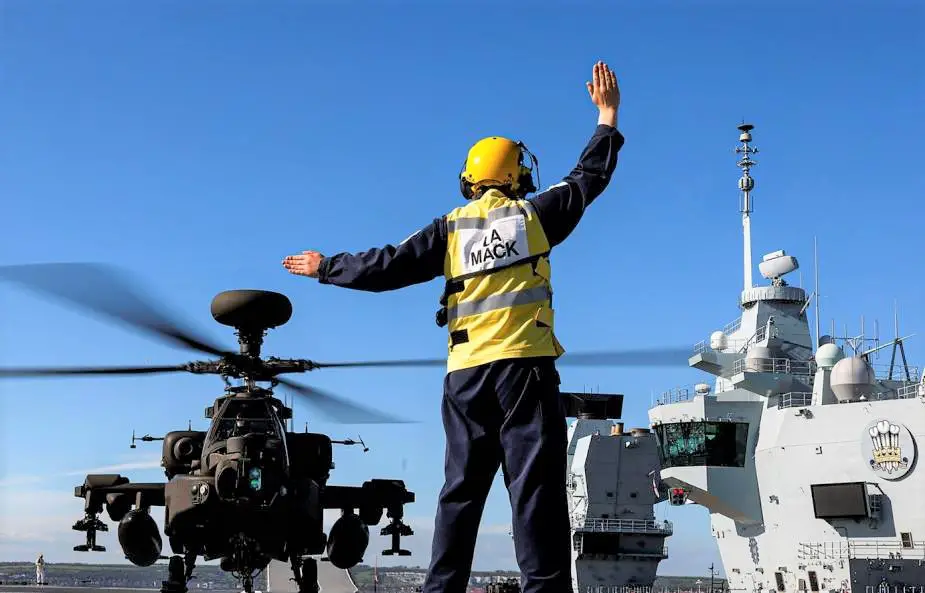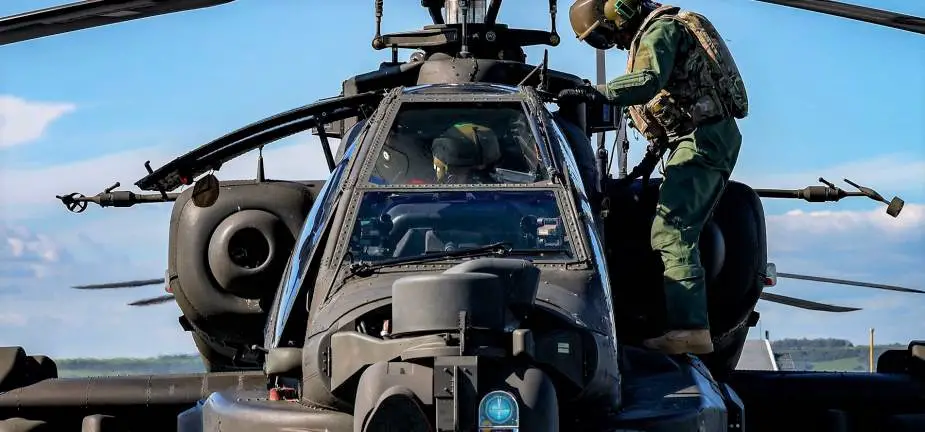Breaking news
British AH-64 Apaches of Sqn 656 completes training with HMS Prince of Wales.
The most powerful battlefield helicopter in Britain’s arsenal has completed two weeks’ intensive training on the nation’s newest aircraft carrier, the British MoD reports. Three AH-64E Apache gunships joined HMS Prince of Wales to allow the Army Air Corps’ fliers get their sea legs back – and give the Portsmouth-based warship a taste of the helicopter’s striking power.
Follow Air Recognition on Google News at this link
 Three AH-64E Apache gunships joined HMS Prince of Wales to allow the Army Air Corps’ fliers to get their sea legs back – and give the Portsmouth-based warship a taste of the helicopter’s striking power (Picture source: British MoD)
Three AH-64E Apache gunships joined HMS Prince of Wales to allow the Army Air Corps’ fliers to get their sea legs back – and give the Portsmouth-based warship a taste of the helicopter’s striking power (Picture source: British MoD)
The AH-64E attack helicopters joined the carrier before she departed her home base on her latest series of trials and training in the English and Bristol Channels. The Army Air Corps maintains a specialist maritime Apache squadron, 656, with modified gunships equipped with floatation devices, should one of the multi-million-pound helicopters have to ditch. Otherwise, it remains the same tank-busting battlewagon operated over land.
The emphasis of the squadron’s embarkation on the carrier was ensuring air and ground crew were used to operating at sea – and to train Prince of Wales’ air/air engineering departments in handling, moving, maintaining and launching/recovering the Apache as part of the carrier’s broader air group.
During the fortnight-long spell on the Portsmouth-based leviathan, 656 Squadron shared the flight deck with RAF Chinooks, Royal Navy Merlins and, briefly, the first F-35B Lightning II jets to land/take-off from HMS Prince of Wales. The Army Air Corps fliers landed and took off 161 times, qualified one new pilot for maritime operations by day/night, while eight more regained or maintained their currency.
Instructing the aircrews was veteran Apache pilot Major Tony Thompson with 19 years in the cockpit. This was his seventh embarkation in a ship in five years and he says the Queen Elizabeth class is a challenge for pilots – despite a flight deck large enough to accommodate three football pitches. “HMS Prince of Wales is a much larger ship to land on – but she’s also much darker,” Major Thompson added. Landings are made all the more challenging by the positioning of the helicopter’s two crew behind each other – rather than side-by-side in most cockpits. It means each crew member’s field of vision and reference points for safely landing are different.
And if it’s tough for the crew in the cockpit, the Apache poses challenges for the Royal Navy aircraft handlers who guide it on to/off the deck and move the nine-tonne warbird around. "The Apache presents a unique set of challenges for us to operate on the flight deck, but despite its menacing look the Apache actually has a smaller downwash than Merlin and Wildcat,” explained Leading Airman (Aircraft Handler) James Batley. “For me, as a flight deck director, the Apache’s ability to be almost invisible in the dark makes marshaling and ground movement particularly difficult at night.”
 Three AH-64E Apache gunships joined HMS Prince of Wales to allow the Army Air Corps’ fliers to get their sea legs back – and give the Portsmouth-based warship a taste of the helicopter’s striking power (Picture source: British MoD)
Three AH-64E Apache gunships joined HMS Prince of Wales to allow the Army Air Corps’ fliers to get their sea legs back – and give the Portsmouth-based warship a taste of the helicopter’s striking power (Picture source: British MoD)


























